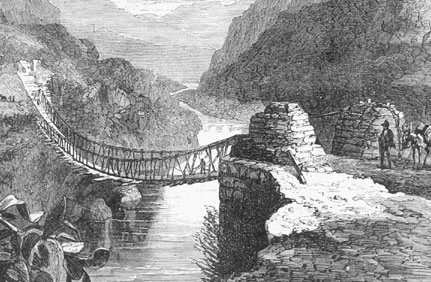 |
|
||
|
|||

Bridge to the past
If the new Leonard Zakim bridge looks sleek and elegant next to the Tobin, consider the technological wonders of Inca civilization: slender suspension bridges comprising nothing more than braided grass and wood fibers. At the height of the Inca empire, hundreds of suspension bridges spanned canyons and rivers in the vertiginous regions of the Andes Mountains. While the bridges were critical connections in a vast road system throughout the Andes, few scholars have studied their historical and cultural significance. On March 24, the CAS archaeology department will host a public lecture by John Ochsendorf, an MIT assistant professor of architecture, who has traveled across Peru studying these ancient structures. Many bridges, like the one at left over the Apurimac River in Peru, which 19th-century American explorer Ephraim George Squier sketched in his travels, survived for centuries after the fall of the Inca empire. Ochsendorf will focus on the last remaining bridge, a 500-year-old specimen made entirely of grass. He will bring samples of the grass cables from the bridge, and will discuss laboratory testing of the strength of these materials. “Inca bridges are kind of the love of my life,” he says. “I see lessons in them for today’s designers. They’re a great example of linking a maintenance plan with the community and using materials that are locally available and renewable. The role of these bridges in the history of South America is immense and completely understudied. I think it’s the ultimate Ph.D. topic.”
Ochsendorf’s lecture, Inca Suspension Bridges, takes place on Monday,
March 24, at 5 p.m., in CAS 326. The lecture is free and open to the public.
![]()
21
March 2003
Boston University
Office of University Relations